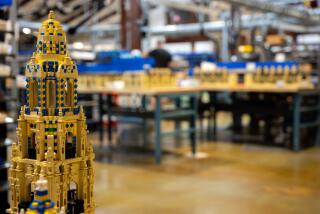Lego Vision
- Share via
Like many 20th century adults, Henry Lim spent much of his childhood constructing buildings, vehicles and dioramas from the colorful little plastic bricks brought to the world in 1949 by the Denmark-based Lego Corp. Lim, 31, abandoned Legos as he succumbed to adolescence and the charms of supposedly bigger-and-better toys. But in 1999 he read about a Lego sculpting competition on a “Star Wars” Web site challenging entrants to sculpt a figure from “Star Wars Episode I: The Phantom Menace.”
With no experience, much less an instruction sheet, Lim proceeded to build a 5-foot-tall rendition of Queen Amidala in a month, using the contents of 46 1,200-piece Lego tubs. “I have a natural talent for looking at something and having it translate,” he says. Lim took first place after submitting a digital photo of his work to the Web site’s creator. He didn’t win anything save the adulation of the Lego community, but he rediscovered the simple pleasure of making stuff with tiny interlocking blocks.
About that “Lego community.” Along with gazillions of enraptured children, a worldwide subculture of grown-ups has developed devoted to building elaborate space scenes, castle scenes and train scenes to the scale of “minifigs,” as fans call the little yellow-headed Lego action figures. The cult owes much of its cohesion to Internet message boards and Web sites such as www.lugnet.com, www.bricklink.com and www.brickshelf.com. Lego sculpting contests don’t offer big-money prizes, but the competition is fierce.
Thanks to the Internet and the obsessive splendor of his creations, Lim rapidly became a star in the Lego community. Barring the artisans Lego employs to build pieces for the Lego theme parks in England, Denmark, Germany and Carlsbad, Calif., Lim estimates that there are five to 10 people in the world making large-scale art using Legos; he can think of only one American, Eric Harshbarger of Alabama. Lim is also one of about 30 members of the Lego User’s Group of Los Angeles, an organization that meets bimonthly to swap bricks, share ideas, whine about their non-Lego-loving significant others (Lim is currently single) and generally revel in all things Lego.
Lim’s creations have included a 2 1/2-by-5-foot mosaic of the Beatles, a 3-foot-tall bust of Ludwig van Beethoven, several commissioned pieces and a working harpsichord that weighs 150 pounds and took two years and about 100,000 pieces to complete. Like most Lego artists, this stickler avoids glue unless requested. “In the Lego community there is a purist code,” he says.
Lim works as a technical services librarian at the UCLA music library. When not building Lego art or hanging out with his Lego group pals, he composes classical music, scores student films and takes digital photographs. While he considers Lego art a hobby, it has taken over aspects of his life--like his apartment. Lego projects and spare parts occupy most of the living room and a bedroom. His most recent creation: a 14-foot-long, 3-foot wide, 6-foot-high stegosaurus that took more than 100,000 Legos, eight months and upward of $3,000 to build. “Legos are pretty expensive,” says Lim, who receives no discounts or freebies from Lego. But money isn’t the motivating force here. “It’s fun,” he says. “I’m amazed that people are amazed at what I do.”
*
GLOSSARY
MINIFIGS: Legophile slang for Lego action figures
AFOL: Adult Fan of Lego
NLS: Non-Lego Spouse
NLSO: Non-Lego Significant Other
LUGOLA: Lego User’s Group of Los Angeles
More to Read
The biggest entertainment stories
Get our big stories about Hollywood, film, television, music, arts, culture and more right in your inbox as soon as they publish.
You may occasionally receive promotional content from the Los Angeles Times.










